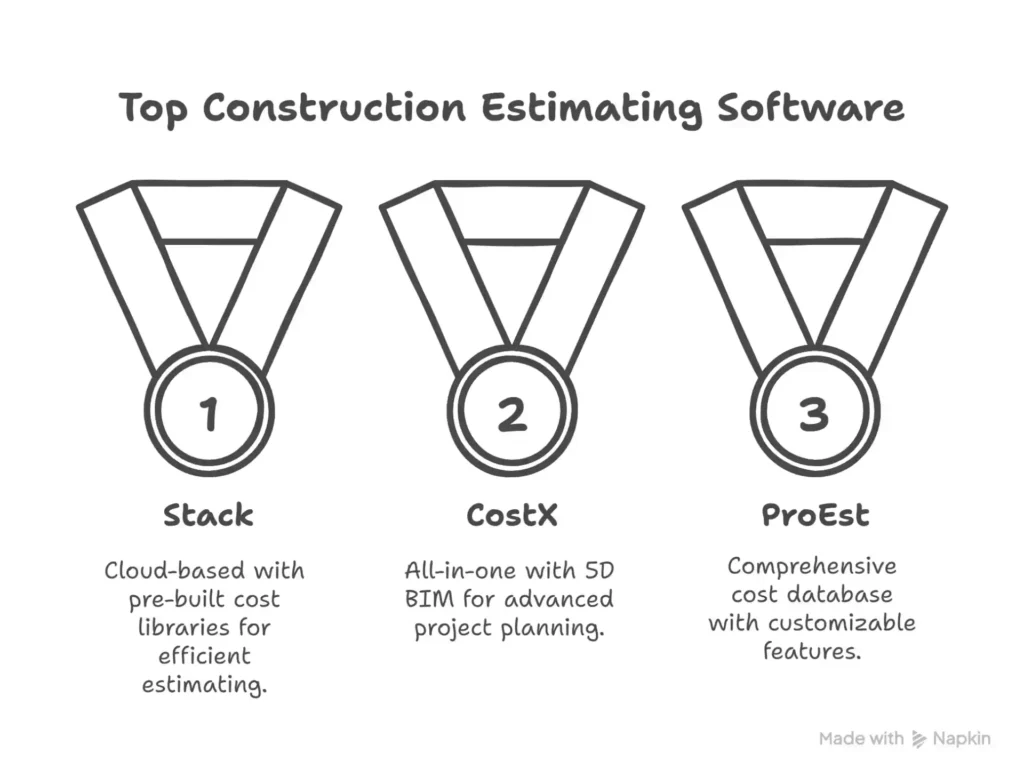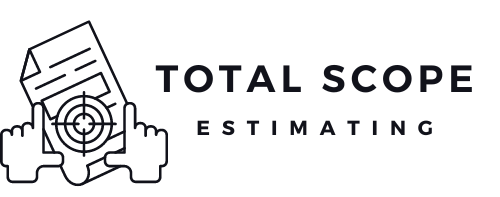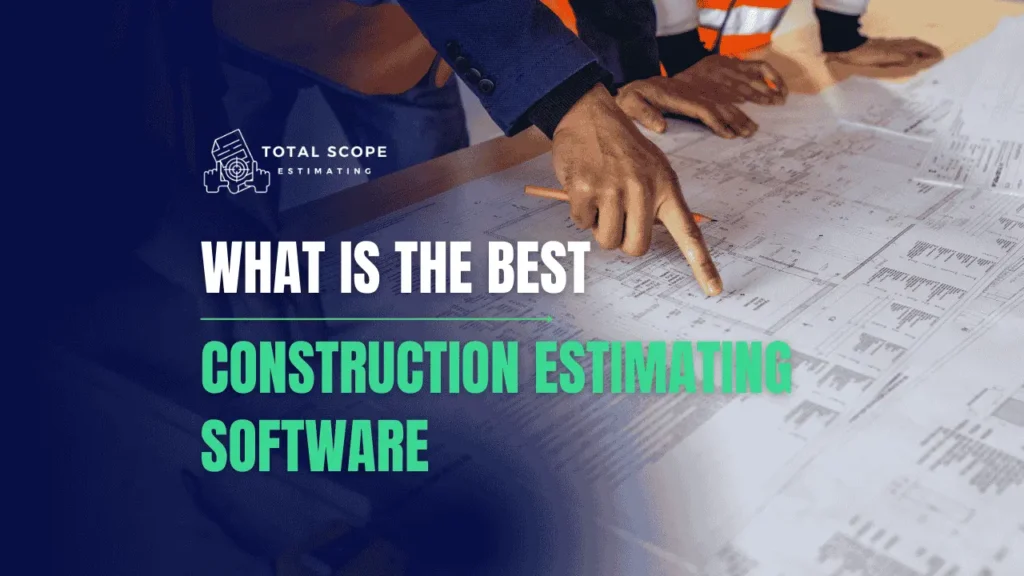In the dynamic construction world, estimating is the only thing that can make or break any project. Accurate estimating sets a strong foundation for the project scope and budget and for various stages, such as planning, procurement, execution, and completion. The firm setting stone holds onto the entire structure of the construction project.
However, preparing meticulous estimates is not easy. It requires an in-depth knowledge of technology, vast experience, and a profound understanding of the intricacies of the construction project. This is where construction estimator software, the most crucial part of construction, steps in, leading to the smooth alignment of your construction business. But with so many options available, how do you decide which is the best construction estimating software for your needs?
In this article, we’ll explore the 17 most popular construction estimating software tools on the market. But before we dive into the list, let’s cover some essential groundwork—what differentiates traditional estimating tools from dedicated construction estimating software, how to choose the right solution for your business, and which trends are shaping the future of estimating.
What Is Construction Estimating Software?
Construction estimating software helps companies, construction managers, and contractors better align the cost calculation process. Its exciting features are its accuracy, automation, and speed. Before starting the construction, the contractors are required to submit the bids. These comprise all the information, such as the quantity and type of materials needed, the number of staff hours it will take to complete the project, and all the cash and resources allocated.
A construction project can only start with a rough draft of a cost estimate. Cost estimates tend to fluctuate as prices are updated over time. Some items need to be included or more represented in the cost estimate. There is a massive margin of human error at this point. So, software for construction estimates assists us with its automation and accuracy. It arranges all the data and gives the estimated pricing with a few clicks.
Difference Between Estimating Tools and Construction Estimating Software
Not all estimating methods are created equal. Traditional estimating tools like Excel or manual worksheets can be cost-effective and flexible, but they also come with limitations: human error, time consumption, and lack of scalability.
In contrast, construction estimation softwares are specifically built to meet the demands of the industry. They include features like:
- Digital blueprints and quantity takeoff
- Real-time material pricing databases
- Integration with accounting and project management platforms
- Automation of repetitive calculations
- Error-checking and validation tools
- Cloud access for remote teams
While basic tools can work for smaller or one-off projects, investing in a construction project estimating software ensures greater accuracy, saves time, and improves collaboration—making it an essential asset for growing businesses.
The Concept of Construction Estimating Software
Understanding construction cost estimating software, especially the most popular options, requires a solid grasp of the preconstruction bidding process. Here’s a closer look:
1. Preconstruction: The Bidding Process
This phase is key in managing a construction project. It lays out the foundation for the project’s budget, timeline, and resource needs. Contractors and builders submit bids to project owners, detailing the estimated costs to complete the project.
2. Role of the Most Popular Construction Estimating Software
The best software for estimating construction costs helps streamline and simplify this bidding process. It generates detailed cost estimates based on project plans, timelines, insurance needs, and other factors. By automating this process, the software helps ensure that bids are competitive, realistic, and profitable.
3. Differences in Public & Private Project Requirements
Public projects, usually funded by government agencies, have stricter, more regulated bidding procedures. Private projects, on the other hand, offer more flexibility regarding who receives the bid package. These differences can affect how estimates are prepared and should be considered when choosing the best estimating software.
In short, understanding the preconstruction bidding process and how construction estimating software works allows contractors to make smarter choices. The benefits of using the most popular estimating tools—efficiency, competitiveness, and profitability—make them essential in today’s construction industry.
Key Benefits Of Best Construction Estimating Software
- It aids contractors, construction companies, and business owners in drafting accurate estimates and helps them move away from time-consuming tools. It also instills trust and confidence in client contractors.
- Serves users and clients with as automated tools as possible for data entry and retrieval, along with speed and high accuracy.
- Reduces the potential to forget to cross-check the available items and materials required.
- It enables the construction contractors and clients to adjust the instant quantity takeoffs and construction cost estimates easily.
- It tracks any cost deviations from the original tract and alerts the contractors and clients about the change. Thus, it helps to stay focused on the same price.

Kinds Of Construction Estimating Software
Two particular subsets of construction estimating software include takeoff and bid management. These solutions help small construction contractors, and firms organize and integrate them to create a practical construction framework.
Takeoff—This function of estimating software for construction automates data entry and quantifies the materials and resources required from the start of the construction process to project completion. It aligns well with the bidding process and displays all kinds of expenses incurred during the construction.
Bid Management- This function of construction software for estimating simplifies and automates the manual process of bid preparation, filing, submission, and approval, which are crucial parts of a construction project to secure and win over more projects.
Types of Construction Estimating Software and Their Functions
| Software Type | Main Function | Best For |
| Takeoff Software | Automates data entry and material quantification. | Contractors who need accurate material measurements and resource planning. |
| Bid Management Software | Streamlines the bid preparation, submission, and approval process. | Construction firms needing to handle multiple bids efficiently. |
| Project Estimating Software | Integrates takeoff and bid management for end-to-end project cost estimation. | Larger businesses handling complex projects that require integration across teams. |
| Data-Driven Estimating Software | Uses historical data to predict costs based on past projects. | Businesses that rely heavily on past performance and data analytics for decision-making. |
Features To Look For In the Most Popular Construction Estimating Software
Best software for estimating construction costs displays several essential features that are listed below:
Real-Time Calculations
Construction estimation software automatically determine and predict the costs of materials and equipment that will likely be incurred in the construction project. The construction cost calculators automatically update the prices as the construction process progresses.
Adjustments to Specific or Overall Bid Estimates
The software can monitor and control costs during the construction process and, if available, offer recommendations for any economical alternative. This helps to streamline the project’s progress.
Blueprint or Computer-Aided Design (CAD) Image Import and Export
It facilitates importing or exporting existing or newly developed computer-aided designs.
Proposal Templates
Construction estimating software has dual options for proposal templates. Either the software comes with already-present proposal templates, where you just need to drag the template and enter data points into it, or you can create specialized proposal templates custom-made to your clients’ needs.
Proposal Generator
It should be capable of extracting data from takeoff, the resource cost database, the historical database, and any imported data into an integrated proposal generator. The proposal generator is responsible for accurately and precisely calculating bids filed as an essential part of the construction project.
Takeoff
With the takeoff software, contractors can effectively quantify the materials required during construction.
Additional Features In Popular Construction Estimating Software
Historical Database
Construction estimating software provides its users with access to a database that already contains information such as the amount of material used, the number of employees recruited, the number of staff hours paid, the jobs completed, and other relevant data about the construction project. Using this data, the contractors can better estimate the costs by thoroughly reviewing the history.
Materials and Resource Cost Database
The software for construction estimates provides its users with access to the date containing material types, quantities, and the cost of materials used in the project. Thus, the contractors can easily learn the comprehensive and latest prices of materials for procurement.
Project Progress Reporting and Tracking
Although the takeoff software doesn’t provide its users with an extensive project management function, it helps track the construction process’s different phases. Consequently, clients can regularly cross-check the initial estimate with the latest progress.
Who Uses Construction Estimating Software?
All kinds of stakeholders in the construction business regularly use estimating software for construction. Construction firms and contractors who don’t want their projects to overflow their budgets pull historical databases from the software to analyze the budget estimates accurately. Despite the existence of trade-specific constrcution estimator software, many general contractors and construction firms believe in the efficiency of construction estimating software. Construction firms in NYC, in particular, benefit from specialized construction cost estimating services that leverage this software for precise budget management and project efficiency.
17 Most Popular Construction Estimating Software?

Now that we’ve covered the key features to look for let’s explore some of the most popular construction takeoff software options currently available:
1. Stack
Stack has been one of the most popular construction estimating software programs since its origin in 2011. Its cloud-based nature has drawn specific attention from contractors and project managers worldwide. It has been designed solely for the purpose of streamlining the construction project and increases the accuracy and precision of the construction projects by bringing everything on one platform.
Key Features & Benefits:
- Being cloud-based estimating software, it offers the facility to work on the construction project at any time and from any location in the world. Users can access all the data on their devices conveniently. This facility is not usually offered by traditional estimating tools..
- Stack allows multiple users to work on the construction project at the same time, on their own convenience. This reduces the time delays and improves the coordination among team members.
- Stack has it’s own pre-built cost libraries, which reduces the need to enter the data manually. This leads to increased efficiency and accuracy, speeding the project progress.
- Stack also offers the facility of integration with other accounting and project management software, thus reducing the likelihood of duplicating the work and transferring it to other software.
Pricing:
Cost ranges from $2199-$2999/year.
Pros:
- It’s cloud-based nature allows the users to be flexible to work, at any tiem and from any part of the world.
- It facilitates its users to work simultaneously, in real time, increasing the team cooperation.
- It has it’s own pre-built cost library which reduces the need for manual entry and speeds the process.
- Unlike the other traditional software, it offers integration with other project management software, to ensure the seamless flow of work.
Cons:
- It’s navigation is not easily understood by common sense and may require a training, which may be challenging for new users.
- Since it is cloud-based solution, it requires a stable internet connection to work, which may not be ideal for poor-connectivity regions.
- Although it has a pre-built cost library, but it’s data may be limited. Users need to add more to tailor it to their project specifications.
2. CostX
CostX, developed by Exactal, is an all-in-one estimating solution built to simplify and enhance the construction estimation process. Known and used worldwide, CostX stands out for its ability to combine 2D and 3D quantity takeoffs in a collaborative environment, making it a go-to tool for many construction professionals.
Key Features & Benefits:
- CostX supports 5D BIM, allowing users to link cost and scheduling data directly to 3D models—bringing estimates closer to real-world project planning.
- Users can open and perform takeoffs directly from DWG or DXF files thanks to the software’s built-in CAD engine.
- When measurements change, those updates instantly reflect in the associated workbooks, reducing errors and keeping estimates current.
- CostX offers floating network licenses, letting teams share access efficiently and cost-effectively.
Pricing:
Price is available on individual request.
Pros:
- The advanced 5D BIM capabilities position CostX as a modern solution that adapts to evolving construction practices.
- With tools covering everything from takeoffs to project planning, CostX delivers a full suite of estimating functions in one place.
Cons:
- Because it’s packed with features, beginners may find the layout and navigation a bit overwhelming at first.
- CostX is on the pricier side, which might make it less accessible for smaller contractors or firms.
- Getting comfortable with the software and using its full potential requires a solid time investment.
3. ProEst
ProEst has been delivering the construction estimating software across the globe since its establishment in 1976. It has served more than 8000 construction firms worldwide and its product is one of the most popular construction estimating software among contractors and sub-contractors. It has been serving as a separated platform in estimating, with all the comprehensive features.
Key Features & Benefits:
- Among all the other construction takeoff software available in the market, Proest offers the most comprehensive cost database, which makes it an ideal choice for all the contractors and estimators.
- It is highly customizable and users can tailor it perfectly, according to their project requirements.
- It is a cloud-based solution which means that the users can access the data from anywhere and at any device, which is connected to the internet.
- Unlike the other traditional software, it breaks the stereotype of offering spreadsheet-based design. It serves its clients with a user-friendly interface, which is easy to understand and navigate.
- It offers its pricing in annual plans which is flexible for various businesses as they tend to grow.
Pricing:
Pricing is available on inquiry.
Pros:
- It offers a comprehensive cost database, without compromising on the quality.
- It is cloud-based, which makes it accessible to all and flexible to work.
- It provides a user-friendly navigation which can be customized according to the client’s requirements.
- It serves an annual pricing plan which means there is great scalability for the growing businesses.
Cons:
- Some clients report issues in creating data assemblies, from the outset.
- It is costly, as compared to other available options in the market.
- It requires an expertise to fully utilize the pre-built and extensive cost database.
4. CostOS
CostOS, developed by Nomitech, is a powerful estimating tool designed to serve the needs of construction firms ranging from small businesses to international enterprises. It supports everything from early-stage conceptual estimates to highly detailed cost projections.
Key Features & Benefits:
- Users can create fast, accurate estimates using BIM models and parametric data, greatly speeding up the process.
- All cost information is stored in a single, secure location that’s accessible from anywhere, ensuring data consistency across teams.
- CostOS can sync with ERP systems, enabling smooth information flow across departments.
Pricing:
Pricing available on request with a free demo.
Pros:
- With support for multiple currencies and regions, CostOS is especially useful for companies operating across borders.
- The combination of BIM and parametric estimating tools helps reduce the time needed to produce accurate estimates.
Cons:
- New users, especially those unfamiliar with BIM, may need time to get fully comfortable with the software.
- Some users feel the platform could be more intuitive when it comes to customizing workflows or reports.
5. Clear Estimates
Clear Estimates was launched by a team of remodelers in 2004, who wanted to change the concept of estimation. They wanted it to be cost-effective, less time-consuming and most precise tool for construction estimating. Over the time, it has developed into a cloud-based construction takeoff tool that has drawn the interest from the contractors specifically the small contractors and remodelers across the globe.
Key Features & Benefits:
- Clear Estimates has various pre-built parts database with over 60 different sections, which allows the users to create accurate and precise estimates.
- It was created by having a concept of simple estimating tool in mind, which offers an easy-to-use interface.
- It easily integrates with other software specifically Quickbooks, allowing the users to keep a record of their expenses and profits.
- It serves its users by offering customizable templates, by which they can create and save their own custom projects.
- It is cloud-based, which can be accessed at any device and location across the globe.
Pricing:
Its price ranges from $79 to $249/month-billed monthly, based on the eatures you require.
Pros:
- Its preloaded parts database makes it easy to create more accurate and reliable cost estimates.
- It is simple to use, which is great for small businesses and individual contractors.
- It facilitates by seamlessly integrating with QuickBooks, allowing to track project expenses and profits.
- It has customizable templates, which can be saved and thus, less time-consuming for recurring projects.
Cons:
- Some users report that it has limited functionality_having less comprehensive features as compared to other options in the market.
- It’s simplicity may not make it much effective for large and complex construction projects.
- It has limited integration_offering only with QuickBooks, which may not be enough for many contractors and construction businesses.
6. Sage Estimating
Sage Estimating is one of the extensive suite of Sage Estimating. It was developed in 1981, to fulfill the modern needs of construction estimating over the time. Since it’s establishment, it has been one of the most popular and best construction estimating software in the construction market, providing accurate and detailed cost estimates.
Key Features & Benefits:
- Sage Estimating has teh feature of comprehensive estimates which allows the users to produce accurate results by combining the digital plan takeoff and cost database.
- It has an extra and nost useful feature of audit trail, which allows the users to track each entry and prevent mistakes.
- It seamlessly integrates with other Sage Estimating software, which makes it convenient for the users to manage the project effectively.
- With Model Estimating, it allows the users to utilize the pre-built cost packages, thus speeding their estimating and reducing time delays.
- It’s SQL Database facilitates the users by its powerful listing and reporting, allowing for more precision.
Pricing:
Pricing varies based on the number of users, various modules and extra features.
Pros:
- It’s extensive database set allows the users to make accurate estimates, while covering each aspect.
- It’s model estimating allows for more easy and precise listing and reporting in the digital takeoffs.
- It’s easy integration with other Sage Estimating tools makes it convenient to be used for the entire project management.
- Having the audit trail, it allows the users to have flexible and transparent estimates, by tracking each change.
Cons:
- Sage Estimating is a powerful software, and may be challenging for beginners or those, who are new to the world of estimating.
- As compared to the other options available in the market, it is expensive and thus, less beneficial for small businesses and individual contractors.
- It easily integrates with Sage Estimating tools but may not seamlessly integrate with Non-Sage estimating tools.
7. ConQuest Estimating Software
ConQuest Estimating has been helping construction professionals estimate projects more accurately and efficiently for over 30 years. With more than 900 companies relying on it, ConQuest is known for improving bid success rates, reducing risk, and helping businesses maintain healthy profit margins.
Key Features & Benefits:
- ConQuest covers the full pre-construction process—from takeoffs and resource planning to subcontractor management, bid analysis, and final handover.
- With a database of over 10 million costed items, building detailed and accurate estimates is fast and straightforward.
- The interface is clean and practical, making it easier for new users to get up and running without a steep learning curve.
- You can access ConQuest from anywhere, on any device, which is great for remote teams and job sites.
- Businesses can choose a package that fits their needs, and add on advanced features as they grow.
- Everything from estimating to subcontractor coordination is connected, helping teams work more efficiently.
Pricing:
Pricing is not publicly available.
Pros:
- Automates and organizes the estimating process to reduce manual effort and errors.
- The extensive cost library helps produce detailed estimates quickly and confidently.
- Makes it easy to collect and evaluate bids from subcontractors.
- Provides a clear view of the estimating pipeline, helping project managers make better decisions.
- Offers customer support and training to ensure teams get the most out of the software.
Cons:
- Since it’s cloud-based, a reliable internet connection is necessary, which may be a hurdle in remote areas.
- Tailoring the software to your needs like importing your cost database or integrating with other tools, may take some initial effort.
- ConQuest isn’t the cheapest option on the market, so smaller businesses may need to weigh the investment against their budget.
8. Procore Estimating
Procore is one of the foremost supplier of construction management software. Keeping the idea of integration and streamlining the world of construction estimation, it launched it’s main product in 2002. Procore Estimating is a brand new addition in their product list but serves the same purpose of digitalizing the construction estimation and improving collaboration among team.
Key Features & Benefits:
- Procore Estimating Software allows the users to create and save the cost estimates within the Procore platform, thus reducing the time delays and work duplication.
- It allows the multiple users to work on the same estimate simultaneously, thus improving the team collaboration and cooperation.
- It seamlessly integrates with other Procore Estimating solutions, making it all-in-one solution for contractors and estimators.
- It has an additional feature of cost tracking which enables the users to track the changes in the estimate according to the real-time prices.
- It has another extra feature of customizable reports, by which users can produce customized reports and use them to gain useful information and make informed decisions.
Pricing:
Pricing available on inquiry.
Pros:
- As it a part of Procore estimating, which enables the users to combine it with other Procore tools for an effective project management.
- It’s collaborative features to allow the users to work simultaneously on the same project, improves the team cooperation.
- It’s real-time cost tracking allows to adjust the estimates according to the ongoing market prices and trends.
Cons:
- As compared to the other options available in the market, it may be expensive for small businesses, as it is a part of Procore suite.
- As compared to estimating tools established earlier, it may not be as effective for estimating when ut comes to huge or complex projects.
- Those businesses or contractors who are not using Procore for their project management, may find it difficult to integrate it with other project management tools other than Procore.
9. Buildxact
Buildxact is a cloud-based software solution that was first introduced in Australia in 2010. It was created with small builders and remodeling professionals in mind, offering an all-in-one platform to manage estimates, job schedules, and overall project tasks with ease.
Key Features & Benefits:
- Buildxact speeds up the estimating process by helping users create accurate quotes, track costs, and compare prices from various suppliers—all in just a few clicks.
- Beyond estimating, it includes tools for scheduling, purchasing, invoicing, and general project tracking, making it a true end-to-end solution.
- The software connects smoothly with well-known accounting platforms like Xero and MYOB, simplifying bookkeeping and financial management.
- Being cloud-based, Buildxact allows users to work on their projects remotely—ideal for teams on the move.
- Designed specifically for smaller construction businesses, it delivers the right mix of features without overwhelming users with unnecessary complexity.
Pricing:
Its price ranges from $133 to $356/month-billed annually, based on the number of users and other extra features.
Pros:
- It combines multiple essential tools into a single, easy-to-use platform—covering everything from estimates to project delivery.
- While many construction platforms cater to large enterprises, Buildxact is tailored to meet the specific needs and budgets of smaller contractors.
- Its intuitive design makes it approachable for users who may not be very tech-savvy, reducing the learning curve significantly.
Cons:
- Bigger construction firms may find the features too basic or lacking in advanced capabilities they require.
- As an Australian-born platform, some of its default settings and workflows might need tweaking to suit international users.
- While it covers the basics, Buildxact doesn’t offer as many third-party software integrations as some of the more established competitors in the market.
10. Destini Estimator
Destini Estimator is a comprehensive constrcution estimating software, developed by Back Technology. It was designed with a concept of improving the collaboration and an easy-to-use navigation. It incorporates BIM technology to help the construction professionals and remodelers in their estimating tasks.
Key Features & Benefits:
- It has integrated 2d and 3d takeoff capabilities, which allow the users to perform an accurate estimating of even complex projects.
- It has an integration with BIM (Building Information Modelling), by which users can draw information directly from their project models.
- It has collaborative features, allowing the team members to work simultaneously on the same project, reducing the time delays.
- It offers a customization feature, through which any estimate can be tailored perfectly according to the company’s requirements.
Pricing:
Pricing is based on the unique needs of the project.
Pros:
- Destini Estimator comes with a wide range of tools that make it ideal for more detailed and demanding estimating tasks.
- Multiple users can work on the same estimate at the same time, helping teams stay productive and on the same page.
- The software can be tailored to match your company’s specific workflow, which helps boost both accuracy and efficiency.
Cons:
- Because it’s such a feature-rich platform, it can feel a bit overwhelming at first—especially for those new to estimating software.
- It’s geared more toward mid-sized to large companies, so the pricing may not work well for smaller contractors or solo estimators.
- Some users mention that the layout isn’t the most intuitive, and it may take some time to get fully comfortable using all its functions.
11. WinEst
WinEst is a robut constrcution estimating software, known for it’s database-driven solutions. It was founded in 1977 and since then, it has become a well-reputed estimating tool in the construction field due to it’s extensive functions and easy-to-use navigation.
Key Features & Benefits:
- It has an extensive and customizable cost database, which allows for more accurate and precise results.
- It offers collaborative features, by which multiple people can work on the same project in real time.
- It serves with detailed reporting, allowing to create more detailed reports of takeoffs, cost calculations, bid comparisons and more.
- It offers customizable templates to streamline the estimating process.
Pricing:
Available on inquiry.
Pros:
- It’s database-driven nature allows the users to create more accurate and precise reports.
- It allows teh people to collaborate and improve the cooperation.
- It has customizable templates and uset-friendly interface.
Cons:
- WinEst is a robust estimating software which may be challenging for beginners and may require training to use all it’s features.
- It may be expensive as compared to the other tools in the construction field,
- It is cloud-based which may not be ideal for areas with connectivity issues.
12. PlanSwift
PlanSwift is a user-friendly construction takeoff and estimating tool that’s been helping contractors across industries like electrical, plumbing, and landscaping, since 2008. Its popularity comes from how easy it is to learn and use, making it a go-to choice for pros who want to speed up estimating without a steep learning curve.
Key Features & Benefits:
- Simply click and drag to pull quantities straight from your digital blueprints—no complicated steps needed.
- Build custom formulas to match your specific needs and ensure your numbers are always spot-on.
- Estimate entire systems or groups of items at once, saving time and boosting accuracy.
- PlanSwift connects smoothly with popular construction software, so your workflow stays seamless.
Pricing:
The price of the PlanSwift estimating software is $2,000/year.
Pros:
- Import PDF, CAD, and other file types
- Accurate digital estimate with automatic scaling
- Built-in cost database for materials
- Customizable reporting
- Integrates with accounting and project management tools
Cons:
- It is expensive than other popular construction estimating software in the construction market.
- It may not comprise as much advanced features, as it’s competitors.
13. HCSS HeavyBid Estimating Software
HCSS HeavyBid is a powerhouse estimating tool specifically created for civil construction professionals. It’s trusted by more than 50,000 estimators and over 4,000 companies, including 44 of the top 50 heavy civil contractors listed by ENR. Designed to help contractors build fast, accurate estimates, HeavyBid streamlines the bidding process so you can win more work with less hassle.
Key Features & Benefits:
- HeavyBid lets you import bid items straight from DOT websites, which means you can build out estimates in a fraction of the time it would normally take.
- It plays nicely with external takeoff tools, allowing you to bring in quantities and bid items directly for smooth and accurate cost calculations.
- Multiple estimators can work on the same bid simultaneously, which makes teamwork much more efficient.
- You can tailor proposals to match the exact format that a project owner requires, keeping you compliant and professional.
- Automatically pulls in project data so you can analyze performance and improve future bidding strategies.
- Seamlessly move data to and from tools like Primavera, Microsoft Project, and over 30 accounting systems.
- Works with popular platforms like Vista, QuickBooks, and Sage 300, making sure your estimating, accounting, and payroll systems are all in sync.
Pricing:
Pricing available on inquiry.
Pros:
- HeavyBid cuts down on manual entry and helps speed up the entire estimating process.
- From activity lists to proposal templates, you can fine-tune everything to fit your workflow and client needs.
- Whether you’re a small crew or a large civil contractor, the software is designed to scale with you.
- Multiple estimators can work together without stepping on each other’s toes.
- HCSS offers 24/7 customer support and a structured 90-day onboarding process to get teams up and running smoothly.
Cons:
- With so many features packed in, new users might need some time to get fully comfortable.
- It’s a premium tool, so smaller contractors might need to weigh the cost against their budget.
- Integrating HeavyBid with your existing systems and setting up templates may require a bit of upfront effort.
14. Estimator 360
Estimator 360 is a cloud-based construction estimating and management software. Keeping the idea of simplicity in mind, it was designed to facilitate the process of digital takeoffs. It’s user-friendly interface makes it a popular construction estimating software for small contractors and other construction professionals.
Key Features & Benefits:
- It has an extensive feature of automated estimating, which completely automates the process of construction estimating, including material takeoffs and cost calculations.
- Since it is cloud-based, it allows it’s users to access the data from anywhere in the world, on any device which is connected to the internet.
- It has an additional feature of integrating with supplier-based pricing, which allows the cost tracking in real time.
- It offers customizable takeoff templates, which makes it easier to work with, without compromising on quality.
Pricing:
Price of Estimator 360 for contractors nad lumberyards is $200/month, which is billed annually. For modular builders, it’s cost is $300/month, billed annually.
Pros:
- Having automated estimating, it simplifies the process of construction estimation.
- It’s cloud-based nature makes it flexible to work at any time and from any location.
- It’s integration with supplier-based pricing makes it effective to record teh cost changes in real time.
Cons:
- It has a subscription-based pricing which may not be ideal for all the construction professionals and businesses.
- It’s simple nature may not make it much effective for huge and complex projects.
15. Zebel
Zebel is an emerging cloud-based construction estimation software designed to simplify the process of creating accurate bids for construction projects. It offers a range of features, including digital takeoff, cost estimation, and project tracking, making it a great tool for small to medium-sized contractors.
Key Features & Benefits:
- Zebel allows users to create and manage estimates from any location, making it ideal for teams working remotely or on multiple sites.
- Users can perform takeoffs directly from digital drawings, reducing errors and improving speed and accuracy.
- Zebel allows users to create their own cost libraries, ensuring that estimates are specific to the project’s needs.
- The software includes tools for tracking project costs and performance, helping contractors stay on budget and monitor project timelines.
Pricing:
Pricing available on request.
Pros:
- Zebel’s cloud-based design allows for remote access and collaboration, making it convenient for teams working in different locations.
- The software’s interface is user-friendly, allowing contractors to quickly create estimates without needing extensive training.
- Zebel’s pricing structure makes it accessible to small and medium-sized contractors looking for a cost-effective estimating solution.
- Users can create their own cost libraries, ensuring estimates are tailored to the project.
Cons:
- Zebel may lack some of the advanced tools found in more established estimating software, making it less suitable for large contractors.
- While it offers project tracking, it may not provide the comprehensive project management tools required for larger projects.
16. Houzz Pro
Houzz Pro is an all-in-one business management and construction estimation software designed primarily for residential contractors, remodelers, interior designers, and specialty trades. It includes tools for marketing, client communication, and detailed estimating.
Key Benefits & Features:
- Customizable estimate templates
- Built-in materials and labor cost libraries
- Client collaboration tools
- Invoicing and online payment integration
- Change order tracking
- Lead management and CRM
- Mobile app for on-site estimates
Pricing:
$85 per month after a 30-day free trial.
Pros:
- Very user-friendly interface, especially for small to midsize contractors
- Great for client communication and presentations
- Mobile capabilities make it easy for on-site use
- CRM and marketing tools included
Cons:
- Less suitable for large commercial projects
- Limited advanced estimating features compared to enterprise-level tools
- Customization options are somewhat limited on lower-tier plans
17. Knowify
Knowify is a cloud-based construction estimation software designed for small to mid-sized contractors, particularly those in specialty trades like electrical, plumbing, HVAC, and remodeling. It combines estimating, job costing, invoicing, and project management in one user-friendly platform.
Key Benefits & Features:
- Fast, template-based estimating tools
- Real-time job costing and budgeting
- Integrated time tracking and scheduling
- Progress billing and AIA-style invoicing
- Purchase order and subcontractor management
- Seamless QuickBooks integration
- Mobile app for field teams
Pricing:
$99/month (includes 1 user).
Pros:
- Intuitive interface designed specifically for contractors
- Strong estimating and job costing features for the price
- Excellent for trade contractors and subcontractors
- Good integration with QuickBooks for streamlined accounting
Cons:
- Not ideal for very large general contractors or enterprise-level projects
- Some advanced features require higher-tier plans
- Mobile app has fewer functions than desktop version
Also Read: How To Estimate Construction Costs
Emerging Trends in Construction Estimating Software
The estimating software for construction landscape is constantly evolving. Here are some trends shaping the future of the industry:
AI & Machine Learning
Smart estimating algorithms are helping contractors predict costs, adjust bids, and identify risks with greater accuracy.
Cloud Collaboration
More contractors are using cloud-based construction estimator software to manage remote teams and access real-time updates.
Mobile Accessibility
Estimating tools are increasingly available via mobile apps, enabling field teams to create or update estimates on-site.
Integration with BIM (Building Information Modeling)
BIM-integrated construction estimation software helps contractors generate quantity takeoffs and cost estimates directly from 3D models.
Sustainability and Energy-Efficient Estimates
New platforms are including green building options, allowing for cost estimates that factor in eco-friendly materials or energy-saving designs.
Staying ahead of these trends ensures your business remains competitive and prepared for the future.
Construction Estimating Software For Various Businesses
The ideal software will depend on your specific requirements and the scale of your business.
- Clear Estimates and Buildxact offer competitive pricing and user-friendly interfaces for small construction businesses or individual construction contractors.
- For larger businesses, Sage Estimating, STACK, CostOS, and Procore provide extensive functions and integration abilities that can deal more effectively with complex projects.
- Companies looking for data-driven estimating would get advantages from Destini Estimator and CostX.
- If you’re in the electrical industry, ConEst provides functionalities tailored explicitly for electrical contracting.
- If you manage a remodelling business, Clear Estimates and Buildertrend have a comprehensive database of costs that will prove fruitful to your business.
How To Choose The Best Construction Estimating Software?
When it comes to choosing the right construction estimating software, the primary purpose is to focus on the specific features that cater to the requirements and specifications of your construction project. The following features must be taken into consideration while choosing construction estimating software:
1. Customizability and Flexibility:
It is crucial to be flexible and adaptable to different kinds of projects, contracts, and bidding conditions. The best construction estimating software offers features that meet the requirements and are custom to your construction project and company. These features allow you to create customised proposals, a historical database, a material and resource cost database, unique templates, and particular reporting tools.
2. Integration Capabilities with Other Software:
Construction estimating software should be able to collaborate and integrate effectively with other project management software. You should look for software that can work well with different resources, such as project management tools, accounting software, and customer relationship managers (CRMs). The best construction estimating software enables the smooth flow of information between various systems, thus helping you stay on a competitive edge.
3. Ease of Use and User Interface:
A user-friendly interface reduces the learning curve and increases your team’s learning flexibility. An easy-to-use interface allows you to input data easily, produce reports, and easily access all of its functionalities. An easy-to-navigate interface helps you use it to the maximum of its potential and reduces the chance of potential errors.
4. Customer Support:
In case of any software queries and confusions, the best construction estimating software firms offers instant and effective expert estimating support . They offer a broad scope of services such as live chat, email support, call assistance service and online assistance at various platforms. You should look for construction estimating software firms who are willing to provide you basic training regarding the software usage, so you can benefit from the software maximally.
FAQS
What is construction estimating software?
It’s a digital tool used by contractors to create cost estimates for construction projects. These platforms streamline takeoffs, materials costing, and labor estimates for greater accuracy and efficiency.
What’s the best software for estimating construction costs?
It depends on your business needs. Popular options include ProEst, Buildertrend, PlanSwift, and STACK. Each offers unique features tailored for different contractor types.
Can small contractors use estimating software?
Absolutely. There are several affordable and user-friendly estimating software for construction tailored for small businesses and independent contractors.
Does software for estimating construction costs help with project management?
Many modern tools integrate estimating with project management features, helping you handle scheduling, billing, and documentation in one place.
How much does construction estimation software cost?
Costs vary based on features and user licenses. Entry-level solutions start around $50/month, while enterprise tools can run into the thousands annually.
Is cloud-based estimating software better than desktop?
Cloud-based software offers better accessibility, collaboration, and real-time updates—making it ideal for growing teams and mobile workflows.
Conclusion
Choosing the best construction estimating software is a critical decision that can significantly affect the effectiveness, productivity, and profit margin of your construction business. It’s a tool that can effectively improve your bid accuracy, project management ability, and cost control strategies.
Each construction business is unique, and what works best for one may not work as well for another. But with the right knowledge and clear priorities, you can confidently invest in a solution that grows with your business and sets you apart from the competition.
Ready to take your estimates to the next level? At Total Scope Estimating, we help contractors like you navigate the world of construction project estimating software. Explore our resources, request personalized recommendations, or contact us today to learn how we can support your estimating needs.
I hope you have enjoyed reading this guide, please let me know in the comment section, what you think.
Did you know, that if you are from Texas, you can get our offer of a 35% discount on our Construction Cost Estimating Services in Texas?





